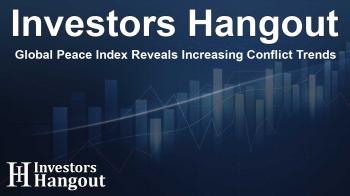Global Peace Index Reveals Increasing Conflict Trends

The 2025 Global Peace Index: A Rising Tide of Conflict
The recently released 2025 Global Peace Index (GPI) by the Institute for Economics & Peace (IEP) highlights a troubling trend of declining global peacefulness. The report indicates that we are witnessing a significant change in the global landscape, pointing to a stark reality where conditions leading to conflict are on the rise, echoing concerns not seen since World War II.
This ongoing transformation, referred to as 'The Great Fragmentation,' captures the essence of contemporary geopolitical shifts. It denotes not only heightened conflict deaths and increased geopolitical tensions but also the assertiveness of middle powers globally. As competition among major powers intensifies alongside emerging asymmetric warfare technologies and financial burdens of fragile economies, the potential for further instability becomes more alarming.
Key Findings from the Global Peace Index
Current Trends in Global Peace
The GPI indicates that global peace is at its lowest point since monitoring began, with many indicators painting a bleak picture for the future. Since 2014, peacefulness has deteriorated annually, with more than a hundred countries witnessing declines over the past decade.
Currently, there are 59 active state-based conflicts, the highest figure since 1945. In 2024, conflict-related deaths surged to 152,000. Furthermore, a disturbing 17 countries reported over 1,000 internal conflict fatalities, marking the worst statistics since 1999.
Despite these dire statistics, a slight silver lining exists, as some indicators have shown improvement—particularly concerning criminality and homicide rates, reflecting a complex picture of global stability.
The Economic Impact of Conflict
Conflict not only engenders human suffering but inflicts severe economic costs as well. The financial repercussions of violence reached an astonishing $19.97 trillion in 2024, accounting for approximately 11.6% of global GDP. This staggering figure is compounded by military spending, which alone amounted to $2.7 trillion.
Countries embroiled in significant conflict have experienced drops in GDP of up to 30% within just a year. Alarmingly, international investment in peacekeeping measures has sharply declined, now constituting merely 0.52% of total military expenditures—marking a historical low.
Regional Dynamics and International Relations
The fragmentation of global influence is becoming more pronounced, particularly as mid-tier powers assert their roles. In the past decade, relationships among neighboring countries have shown marked deterioration, with numerous nations becoming less cooperative.
In terms of influence, the number of countries engaging significantly in others' affairs has nearly tripled since the Cold War, expanding from just 13 to a remarkable 34. This includes nations like Saudi Arabia, India, and Brazil, highlighting the rise of regional powers in today's geopolitical landscape.
Analysis of Conflict Hotspots
As the world looks toward regions fraught with instability, the MENA area remains particularly concerning. Nations such as Sudan, Yemen, Syria, and Israel rank among the least peaceful on the GPI. In contrast, South America is experiencing its best phase of peacefulness, with Peru being a notable example due to reduced civil unrest.
Sub-Saharan Africa faces its own unique challenges, with a startlingly high number of countries caught in the throes of conflict—35 out of 43 nations have faced turmoil over recent years, complicating efforts for peace and stability.
Technological Evolution in Warfare
The nature of warfare is evolving dramatically due to technological advancements. The GPI report reveals that the number of companies producing drones skyrocketed from six in 2022 to over 200 in 2024, significantly changing the dynamics of how conflicts are waged. Ukraine is at the forefront, on track to manufacture over 2.5 million drones by 2025, heralding a new era of AI-enhanced military capabilities.
As these advancements continue, the balance of power is shifting—a development that makes it increasingly challenging to manage conflicts. These small insurgent groups, now equipped with sophisticated technology, can prolong and sustain conflicts against larger, traditional military forces.
Frequently Asked Questions
What is the Global Peace Index?
The Global Peace Index is an annual report by the Institute for Economics & Peace that ranks countries based on their levels of peacefulness and measures various indicators related to safety and security.
How does the Global Peace Index affect global stability?
A declining GPI can indicate rising geopolitical tensions, conflicts, and social unrest, ultimately influencing international relations and global stability.
What are the key drivers behind the decline in global peacefulness?
Major factors include increasing state-based conflicts, geopolitical tensions, financial instability in vulnerable economies, and the rise of middle powers asserting their influence.
Why are military expenditures rising?
In response to rising global tensions and conflicts, many countries are increasing their military spending to bolster their defense capabilities, which can divert funds from essential public services.
What regions are currently experiencing the highest levels of conflict?
Regions like MENA and Sub-Saharan Africa are notably affected, with multiple countries experiencing heightened levels of internal turmoil and violence.
About The Author
Contact Evelyn Baker privately here. Or send an email with ATTN: Evelyn Baker as the subject to contact@investorshangout.com.
About Investors Hangout
Investors Hangout is a leading online stock forum for financial discussion and learning, offering a wide range of free tools and resources. It draws in traders of all levels, who exchange market knowledge, investigate trading tactics, and keep an eye on industry developments in real time. Featuring financial articles, stock message boards, quotes, charts, company profiles, and live news updates. Through cooperative learning and a wealth of informational resources, it helps users from novices creating their first portfolios to experts honing their techniques. Join Investors Hangout today: https://investorshangout.com/
The content of this article is based on factual, publicly available information and does not represent legal, financial, or investment advice. Investors Hangout does not offer financial advice, and the author is not a licensed financial advisor. Consult a qualified advisor before making any financial or investment decisions based on this article. This article should not be considered advice to purchase, sell, or hold any securities or other investments. If any of the material provided here is inaccurate, please contact us for corrections.

